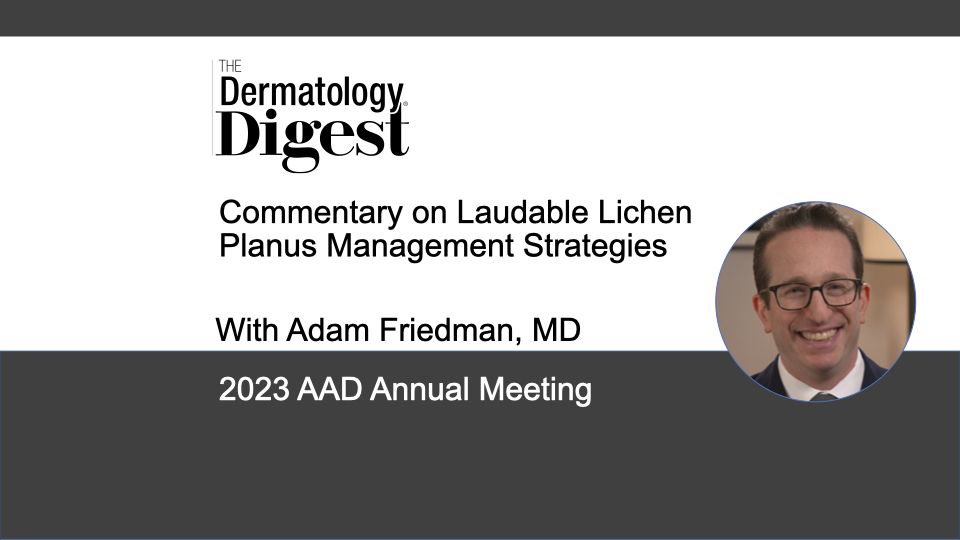Dr. Adam Friedman discusses off-label lichen planus treatments that show promise for treating the disease.
Adam Friedman, MD, FAAD, Professor and Chair of Dermatology, The George Washington University School of Medicine & Health Sciences, Washington, DC
“This is a condition that affects skin, potentially hair, nails, and mucous membranes, and is extraordinarily disabling both due to its clinical appearance, what that clinical disease does to the skin even after you treat it, but also from a symptomatology standpoint,” said Adam Friedman, MD, who presented “Laudable Lichen Planus Management Strategies” as part of the session Treating Tumors and Inflammatory Skin Diseases With Immunomodulators and Biologics at this year’s annual AAD meeting.
“I think many of us remember, even from medical school, the ‘P’s’ of Lichen Planus, pruritus being one of them, and certainly, it could be a relentless pruritus, or a relentless itch, but I think the first point I wanted to get across to the audience was that the condition, like many others, does not follow the textbook—the P’s aren’t always present.”
And because it’s possible to have a variety of presentations, it’s important to keep the differential diagnosis diverse, said Dr. Friedman.
“The focus of my talk was predominantly treatment. …how do we use immunomodulators [off-label] to hopefully give these patients some relief and get this disease under control?”
According to Dr. Friedman, oral retinoids acitretin and isotretinoin have the best evidence for systemically treating moderate-severe disease—more than light therapy, metronidazole, griseofulvin, and immunosuppressants.
“Most of the evidence is behind acitretin, but you have to be mindful in women of childbearing years [and] children. Certainly, there is an indication for using isotretinoin over acitretin, depending on the clinical scenario.”
More often than not with isotretinoin, you don’t need the same doses for nodulocystic acne. Generally, .5 mg/kg body weight is a good dose for isotretinoin, said Dr. Friedman. For acitretin, he starts patients anywhere from 17.5 mg to 20 mg a day and titrates down depending on response.
“But I think, really, the call to action is getting familiar and comfortable using these medications that have been around for a long time to augment disease.”
Notably, oral lichen planus can be worse than generalized disease, said Dr. Friedman.
“It can limit someone’s ability to eat, to drink, to even smile as well as even get proper dental care. So I think when you see cutaneous disease, you always have to look in the mouth, ask about the genitalia, as often oral lichen planus corresponds with general disease as well. And also look at the nails because the patient may not necessarily consider that these are all connected. So it’s important to ask about the other areas that can be involved when you see skin disease.”
According to Dr. Friedman, doxycycline can be effective in treating oral lichen planus.
“I often start at higher doses, 50 mg twice a day, 100 mg twice a day, for several months, as our acne guidelines indicate. And then I drop down to sub antimicrobial doses, whether it be 20 mg twice a day, or 40 mg controlled release. And that does help.”
Other Potential Treatments
Additional therapies used in other areas of dermatology may also hold promise for off-label treatment of lichen planus, said Dr. Friedman.
“In terms of small molecule inhibitors, biologics, there is emerging evidence for the utilization of, for example, aprimilast (Otezla, Amgen).”
A small study showed that aprimilast can help to manage moderate-severe lichen planus, said Dr. Friedman.
“I’ll be honest, it wasn’t amazing, but I think this is accessible medication [with] minimal side effects. So certainly something to consider an option for a disease that once again has nothing on label.”
Interleukin (IL)-17 biologics are even more promising, said Dr. Friedman.
“There is emerging evidence that there is a dysfunction of the Th17 pathway, and the patients with lichen planus have a whole lot of IL-17 that doesn’t belong. …using biologics, that target IL-17 can be effective.”
According to Dr. Friedman, he has had success treating both cutaneous and nail disease with ixekizumab (Taltz, Lilly) and secukinumab (Cosentyx, Novartis). Notably, secukinumab is currently being investigated for the treatment of lichen planus, he said.
“These are drugs we are super comfortable with in the world of psoriasis. I think the challenge is, of course, getting access to the medications off label, but I’ve had some success.”
Interestingly, one case report showed benefit with dupilumab (Dupixent, Sanofi and Regeneron) for severe lichen planus.
“I really can’t reconcile why that would work, as our understanding is this is a Th17 or even Th1 disease, but maybe there’s something to do with Th2. Who knows?”
According to Dr. Friedman, the overall takeaway here is that dermatologists need to be creative with available options for treating lichen planus.
“Everything is off label, which I think is one of the most fun things about being a dermatologist. We are the off-label bandits. We take our understanding of how a drug works, what the underpinnings of the disease are, and we marry them, we bring them together on a successful Tinder date. And we make magic and get patients feeling better.”
But that’s not enough, he said.
“The end all be all is we need things on label because that then allows easier access, hopefully, to these drugs. Right now, it’s letters of medical necessity. It’s begging and pleading with pictures and heartfelt letters, or treating these patients, which I can fortunately do, with samples. So we are very limited.”


